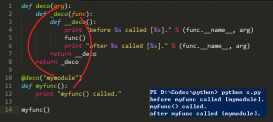内置方法 说明
__init__(self,...) 初始化对象,在创建新对象时调用
__del__(self) 释放对象,在对象被删除之前调用
__new__(cls,*args,**kwd) 实例的生成操作
__str__(self) 在使用print语句时被调用
__getitem__(self,key) 获取序列的索引key对应的值,等价于seq[key]
__len__(self) 在调用内联函数len()时被调用
__cmp__(stc,dst) 比较两个对象src和dst
__getattr__(s,name) 获取属性的值
__setattr__(s,name,value) 设置属性的值
__delattr__(s,name) 删除name属性
__getattribute__() __getattribute__()功能与__getattr__()类似
__gt__(self,other) 判断self对象是否大于other对象
__lt__(slef,other) 判断self对象是否小于other对象
__ge__(slef,other) 判断self对象是否大于或者等于other对象
__le__(slef,other) 判断self对象是否小于或者等于other对象
__eq__(slef,other) 判断self对象是否等于other对象
__call__(self,*args) 把实例对象作为函数调用
__init__():
__init__方法在类的一个对象被建立时,马上运行。这个方法可以用来对你的对象做一些你希望的初始化。注意,这个名称的开始和结尾都是双下划线。
代码例子:
|
1
2
3
4
5
6
7
8
9
|
#!/usr/bin/python# Filename: class_init.pyclass Person: def __init__(self, name): self.name = name def sayHi(self): print 'Hello, my name is', self.namep = Person('Swaroop')p.sayHi() |
输出:
|
1
|
Hello, my name is Swaroop |
说明:__init__方法定义为取一个参数name(以及普通的参数self)。在这个__init__里,我们只是创建一个新的域,也称为name。注意它们是两个不同的变量,尽管它们有相同的名字。点号使我们能够区分它们。最重要的是,我们没有专门调用__init__方法,只是在创建一个类的新实例的时候,把参数包括在圆括号内跟在类名后面,从而传递给__init__方法。这是这种方法的重要之处。现在,我们能够在我们的方法中使用self.name域。这在sayHi方法中得到了验证。
__new__():
__new__()在__init__()之前被调用,用于生成实例对象.利用这个方法和类属性的特性可以实现设计模式中的单例模式.单例模式是指创建唯一对象吗,单例模式设计的类只能实例化一个对象.
|
1
2
3
4
5
6
7
8
9
10
11
12
|
#!/usr/bin/python# -*- coding: UTF-8 -*-class Singleton(object): __instance = None # 定义实例 def __init__(self): pass def __new__(cls, *args, **kwd): # 在__init__之前调用 if Singleton.__instance is None: # 生成唯一实例 Singleton.__instance = object.__new__(cls, *args, **kwd) return Singleton.__instance |
__getattr__()、__setattr__()和__getattribute__():
当读取对象的某个属性时,python会自动调用__getattr__()方法.例如,fruit.color将转换为fruit.__getattr__(color).当使用赋值语句对属性进行设置时,python会自动调用__setattr__()方法.__getattribute__()的功能与__getattr__()类似,用于获取属性的值.但是__getattribute__()能提供更好的控制,代码更健壮.注意,python中并不存在__setattribute__()方法.
代码例子:
|
1
2
3
4
5
6
7
8
9
10
11
12
13
14
15
16
17
18
|
#!/usr/bin/python# -*- coding: UTF-8 -*-class Fruit(object): def __init__(self, color = "red", price = 0): self.__color = color self.__price = price def __getattribute__(self, name): # 获取属性的方法 return object.__getattribute__(self, name) def __setattr__(self, name, value): self.__dict__[name] = value if __name__ == "__main__": fruit = Fruit("blue", 10) print fruit.__dict__.get("_Fruit__color") # 获取color属性 fruit.__dict__["_Fruit__price"] = 5 print fruit.__dict__.get("_Fruit__price") # 获取price属性 |
__getitem__():
如果类把某个属性定义为序列,可以使用__getitem__()输出序列属性中的某个元素.假设水果店中销售多钟水果,可以通过__getitem__()方法获取水果店中的没种水果
代码例子:
|
1
2
3
4
5
6
7
8
9
10
|
#!/usr/bin/python# -*- coding: UTF-8 -*-class FruitShop: def __getitem__(self, i): # 获取水果店的水果 return self.fruits[i] if __name__ == "__main__": shop = FruitShop() shop.fruits = ["apple", "banana"] print shop[1] for item in shop: # 输出水果店的水果 print item, |
输出为:
|
1
2
3
|
bananaapple banana |
__str__():
__str__()用于表示对象代表的含义,返回一个字符串.实现了__str__()方法后,可以直接使用print语句输出对象,也可以通过函数str()触发__str__()的执行.这样就把对象和字符串关联起来,便于某些程序的实现,可以用这个字符串来表示某个类
代码例子:
|
1
2
3
4
5
6
7
8
9
10
11
|
#!/usr/bin/python# -*- coding: UTF-8 -*-class Fruit: '''Fruit类''' #为Fruit类定义了文档字符串 def __str__(self): # 定义对象的字符串表示 return self.__doc__ if __name__ == "__main__": fruit = Fruit() print str(fruit) # 调用内置函数str()出发__str__()方法,输出结果为:Fruit类 print fruit #直接输出对象fruit,返回__str__()方法的值,输出结果为:Fruit类 |
__call__():
在类中实现__call__()方法,可以在对象创建时直接返回__call__()的内容.使用该方法可以模拟静态方法
代码例子:
|
1
2
3
4
5
6
7
8
9
10
11
12
|
#!/usr/bin/python# -*- coding: UTF-8 -*-class Fruit: class Growth: # 内部类 def __call__(self): print "grow ..." grow = Growth() # 调用Growth(),此时将类Growth作为函数返回,即为外部类Fruit定义方法grow(),grow()将执行__call__()内的代码if __name__ == '__main__': fruit = Fruit() fruit.grow() # 输出结果:grow ... Fruit.grow() # 输出结果:grow ... |















